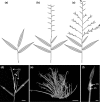Specific in situ visualization of the pathogenic endophytic fungus Aciculosporium take, the cause of witches' broom in bamboo
- PMID: 19465522
- PMCID: PMC2708444
- DOI: 10.1128/AEM.00635-09
Specific in situ visualization of the pathogenic endophytic fungus Aciculosporium take, the cause of witches' broom in bamboo
Abstract
The endophytic fungus Aciculosporium take (Ascomycota; Clavicipitaceae) causes continuous shoot growth in bamboo. The colonized shoot eventually results in witches' broom formation but maintains normal leaf arrangement and branching pattern. To analyze the mechanism of well-regulated symptom development, the location of the fungal endophytic hyphae in host tissues was visualized. A colorimetric in situ hybridization technique using a species-specific oligonucleotide probe targeting the 18S rRNA of A. take was used. In situ hybridization was performed on tissue sections of diseased shoots with or without external signs of fungal colonization. Specific signals were detected in intercellular spaces of the bamboo tissues. Most signals were detected in the shoot apical meristem and the leaf primordia. In addition, fewer signals were detected in the lateral buds, juvenile leaves, and stems. These results indicate that A. take grows endophytically, particularly in the shoot apical meristem of the host. The location of A. take hyphae suggests that the mechanism of symptom development can be explained by the action of exogenous fungal auxin, which continuously induces primordium initiation within the host.
Figures



Comment in
-
Mechanisms of bamboo witches' broom symptom development caused by endophytic/epiphytic fungi.Plant Signal Behav. 2010 Apr;5(4):415-8. doi: 10.4161/psb.5.4.10834. Epub 2010 Apr 2. Plant Signal Behav. 2010. PMID: 20118669 Free PMC article.
Similar articles
-
Henon bamboo flowering recorded first time in 120 years revealed how Aciculosporium take affects the floral organs of the host.Mycoscience. 2024 Aug 9;65(5):228-234. doi: 10.47371/mycosci.2024.06.001. eCollection 2024. Mycoscience. 2024. PMID: 39720017 Free PMC article.
-
Mechanisms of bamboo witches' broom symptom development caused by endophytic/epiphytic fungi.Plant Signal Behav. 2010 Apr;5(4):415-8. doi: 10.4161/psb.5.4.10834. Epub 2010 Apr 2. Plant Signal Behav. 2010. PMID: 20118669 Free PMC article.
-
Phenylpropanoid amides of serotonin accumulate in witches' broom diseased bamboo.Phytochemistry. 2003 Nov;64(5):965-9. doi: 10.1016/s0031-9422(03)00429-1. Phytochemistry. 2003. PMID: 14561512
-
Revision of the genus Aciculosporium (Clavicipitaceae) with a description of a new species on wavyleaf basketgrass, and proline-containing cyclic dipeptide production by A. take.Mycoscience. 2021 May 20;62(3):166-175. doi: 10.47371/mycosci.2021.01.002. eCollection 2021. Mycoscience. 2021. PMID: 37091325 Free PMC article.
-
Grapevine powdery mildew (Erysiphe necator): a fascinating system for the study of the biology, ecology and epidemiology of an obligate biotroph.Mol Plant Pathol. 2012 Jan;13(1):1-16. doi: 10.1111/j.1364-3703.2011.00728.x. Epub 2011 Jun 20. Mol Plant Pathol. 2012. PMID: 21726395 Free PMC article. Review.
Cited by
-
Henon bamboo flowering recorded first time in 120 years revealed how Aciculosporium take affects the floral organs of the host.Mycoscience. 2024 Aug 9;65(5):228-234. doi: 10.47371/mycosci.2024.06.001. eCollection 2024. Mycoscience. 2024. PMID: 39720017 Free PMC article.
-
Understory Dwarf Bamboo Affects Microbial Community Structures and Soil Properties in a Betula ermanii Forest in Northern Japan.Microbes Environ. 2017 Jun 24;32(2):103-111. doi: 10.1264/jsme2.ME16154. Epub 2017 Apr 28. Microbes Environ. 2017. PMID: 28450660 Free PMC article.
-
Microorganism and filamentous fungi drive evolution of plant synapses.Front Cell Infect Microbiol. 2013 Aug 15;3:44. doi: 10.3389/fcimb.2013.00044. eCollection 2013. Front Cell Infect Microbiol. 2013. PMID: 23967407 Free PMC article. Review.
-
Mechanisms of bamboo witches' broom symptom development caused by endophytic/epiphytic fungi.Plant Signal Behav. 2010 Apr;5(4):415-8. doi: 10.4161/psb.5.4.10834. Epub 2010 Apr 2. Plant Signal Behav. 2010. PMID: 20118669 Free PMC article.
-
Localization of helotialean fungi on ectomycorrhizae of Castanopsis cuspidata visualized by in situ hybridization.Mycorrhiza. 2018 Jan;28(1):17-28. doi: 10.1007/s00572-017-0803-y. Epub 2017 Oct 18. Mycorrhiza. 2018. PMID: 29046936
References
-
- Carraro, N., A. Peaucelle, P. Laufs, and J. Traas. 2006. Cell differentiation and organ initiation at the shoot apical meristem. Plant Mol. Biol. 60:811-826. - PubMed
-
- Chen, J. G., S. Shimomura, F. Sitbon, G. Sandberg, and A. M. Jones. 2001. The role of auxin-binding protein 1 in the expansion of tobacco leaf cells. Plant J. 28:607-617. - PubMed
-
- Christensen, M. J., R. J. Bennett, H. A. Ansari, H. Koga, R. D. Johnson, G. T. Bryan, W. R. Simpson, J. P. Koolaard, E. M. Nickless, and C. R. Voisey. 2008. Epichloë endophytes grow by intercalary hyphal extension in elongating grass leaves. Fungal Genet. Biol. 45:84-93. - PubMed
Publication types
MeSH terms
Substances
Associated data
- Actions
- Actions
- Actions
- Actions
LinkOut - more resources
Full Text Sources
Molecular Biology Databases

